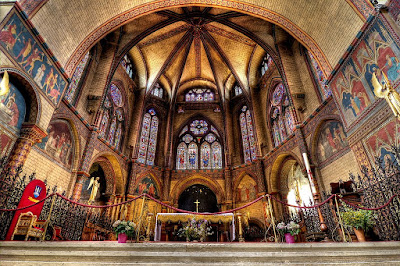 |
| The Relic, pictured here is the Sainte Coiffe or "Holy Headdress" which was used in Jesus' burial can be seen by Pilgrims in Cahors France in 2019. |
|
The Cathedral of Saint-Etienne or Cahors Cathedral in France
is an eleventh century Roman Catholic Cathedral holds a remarkable relic of Christ’s
Passion, the Sainte Coiffe. This relic is a headdress or cloth that was used
during the burial of Jesus. The Sainte Coiffe is also commonly referred to as
the Holy Coif, the Holy Cap, or the Holy Headdress. This relic is rarely shown
to the public however in 2019 Pilgrims will have the special honor of seeing
the relic in person.
 |
| Close up of the Sainte Coiffee - a Relic rarely shown to the public. |
The Cathedral, built by Bishop Gerard de Cardaillac, was consecrated
in 1119 by Pope Calixto II. 2019 will mark the Cathedral’s 900th.
Starting on April 14, 2019, the Cathedral will exhibit the relic of the Sainte
Coiffe prominently at the doorway of the Cathedral so that Pilgrims will be
able to view it immediately upon entering. The details of the exhibit are still
being finalized however the Cathedral will be open each day from 9:00 am to
7:00 pm and the exhibit will run through December 8, 2019.
 |
| The Alter of the Cathedral of Saint-Etienne or Cahors Cathedral in France |
The Sainte Coiffe was given to Charlemagne who then gave it
to the Bishop of Cahors in the year 803 –the Cathedral was later built over a
small seventh century Church built by St. Didier of Cahors. The Sainte Coiffe
shows blood stains that match the stains that appear on the Shroud of Turin.
The “Holy Coif” is made of eight layers of gauze that were
used around Jesus’s head and chin to secure His lower jaw in place.
Hebrew tradition states that blood is holy and
that all blood should be collected and buried along with the deceased. The Holy
Coif, along with the sudarium of Oviedo (two face cloths), the veil of
Manoppello (image of Jesus’ face on a cloth), and the napkins of
Kornelimuenster (a large burial cloth and an ornate burial cloth) were all
linens used in the burial process, preparing Jesus’s body for burial before wrapping
His entire body in Shroud of Turin.
*Source
 |
Pont Valentre – Cahors France
|
Join us on a Pilgrimage visiting the
Best Shrines of France
including a once in a life time viewing of the Sainte Coiffe one of the 2019 departures
below!
Labels: 206 Tours, Cahors Cathedral, France, Jesus, The Sainte Coiffe




